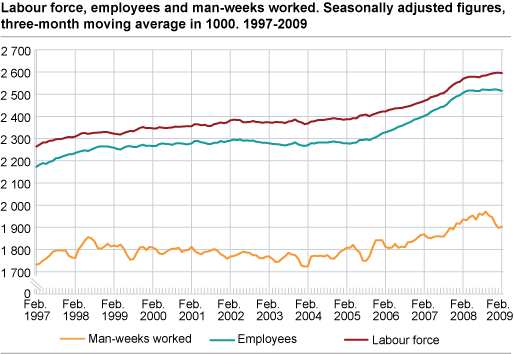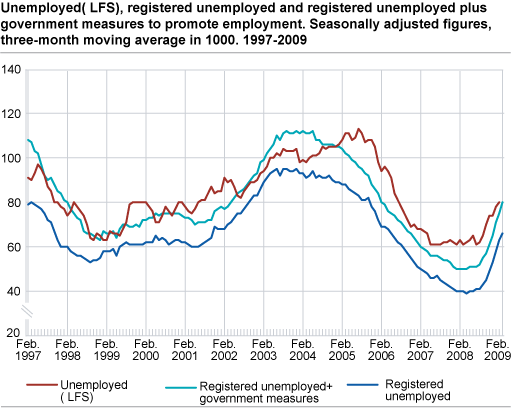Content
Published:
This is an archived release.
Lower labour force participation rate for men
From the first quarter of 2008 to the first quarter of 2009, the labour force participation for men fell by 0.6 percentage points. In the first quarter of 2009, 75.7 per cent of the male working-age population (aged 15-74) was in the labour force.
Seasonally-adjusted figures: Rising unemploymentAdjusted for seasonal variations, unemployment increased while employment was stable from the fourth quarter of 2008 to the first quarter of 2009. Adjustments for seasonal variations allow for the analysis of current developments in the labour market, and serve as an alternative to comparisons with the corresponding quarter in the previous year. Seasonally-adjusted figures are presented in a separate article . |
The labour force (the sum of employment and unemployment) increased by 29 000 from the first quarter of 2008 to the first quarter of 2009. In the same period, the working-age population (aged 15-74) rose by 57 000. The labour force participation rate for men (the labour force as a percentage of the male working-age population) was 75.7 per cent in the first quarter of 2009, 0.6 percentage points lower than in the first quarter of 2008. The labour force participation rate for men aged 55-66 years fell by 1.4 percentage points. The labour force participation rate for women was 70.2 per cent, about the same as in the first quarter of 2008.
Break in the time series
Due to an omission in the data collection during the first half-year of 2008, the employment figures have become too high; approximately 6 000 in the first quarter and 12 000 in the second quarter of 2008. This affects the age group 15-19 and consequently also the whole population aged 15-74. The figures on unemployment are not affected. The tables are not adjusted, but in this article we have made adjustments.
This omission, however, does not affect the seasonally-adjusted figures presented in a separate article.
Employment growth reduced
From the first quarter of 2008 to the first quarter of 2009, employment rose by 15 000 (based on adjusted figures). This was a considerable reduction since last quarter. In the period from the fourth quarter of 2007 to the fourth quarter of 2008, employment rose by 41 000.
The number in employment in health and social work increased by 29 000 from the first quarter in 2008 to the first quarter in 2009.
A new industry classification was introduced as from the publication of the first quarter of 2009. Here is an article presenting general information about the new Norwegian industry classification .
More women in full-time employment
The share in full-time employment among women increased from 56.7 per cent in the first quarter of 2008 to 58.4 per cent in the first quarter of 2009. The average settled working hours for men was 37.0 hours per week, compared with 30.9 hours for women.
Increased unemployment among men
According to the LFS, the unemployment figure increased by 14 000 from the first quarter of 2008 to the first quarter of 2009. The increase in unemployment was among men, while the figure for women remained stable. The unemployment rate stood at 3.1 per cent in the first quarter of 2009, while it was 2.5 per cent in the same quarter of 2008. The rise in unemployment was among people with less than six months searching for work.
The number of registered unemployed with the Labour and Welfare Organisation (NAV) increased by 25 000 in the same period. This is a higher increase than for unemployed in the LFS, and is caused both by different definitions as well as different methods of measurement. The most important reasons for lower growth in the LFS are that persons that have been laid off for less than three months are counted as employed in the LFS, and a reduction in employed persons in the LFS not counted as registered employed with NAV. This last group will for example be young people choosing more education rather than searching for work in a tougher labour market.
More people underemployed
Underemployment is employees with part-time settled working hours who have tried to find more work. The number of underemployed was 62 000 in the first quarter of 2009, 5 000 more than in the first quarter of 2007. In the first quarter of 2009, the underemployed represented 9.2 per cent of all part-time employees, up from 8.3 per cent in the same quarter in 2008.
When accounting for the fact that many unemployed and most underemployed are looking for less than full-time work, these two groups together wanted work that corresponds to 90 000 full-time equivalents in the first quarter of 2009 - up 21 000 from the first quarter of 2007. About 85 per cent of the increase was among the unemployed.
Tables:
- Table 1. Population aged 15-74(1) in the labour force, man-weeks worked, unemployed (LFS)(2), registered unemployed persons and persons employed by government measures (NAV). 1000 and per cent
- Table 2. Population aged 15-74(1) in the labour force, employed persons and unemployed persons by sex (LFS)(2). 1000 and per cent
- Table 3. Persons in the labour force and employed persons aged 15-74, by age and sex (LFS). 1 000 and per cent
- Table 4. Population aged 15-74, employed persons by contractual/usual working hours per week(1) and unemployed persons by age and sex (LFS). 1000
- Table 5. Persons in the labour force aged 15-74 by age and sex. 1000 and as per cent of all in each group
- Table 6. Employed persons aged 15-74, by sex and contractual/usual working hours pr week (LFS). 1 000
- Table 7. Population aged 15-74, by main activity, part-time employment1 and age (LFS). 1 000
- Table 8. Empoyed persons aged 15-74 by major industry division (LFS). 1000
- Table 9. Number of man-hours worked per week1, by industry division (LFS). 1 000
- Table 10. Employed persons,total, and employed persons at work, by status and sex. Number of man-weeks worked1 and actual working hours per week (LFS)
- Table 11. Employed persons aged 15-74 and absence from work1 during the whole reference week, by reason for absence and sex (LFS). 1 000 and per cent
- Table 12. Employees aged 15-74 with temporary jobs, by major industry division (LFS). 1 000 and per cent of all employees
- Table 13. Unemployed persons aged 15-74 by sex and age (LFS). 1000 and per cent
- Table 14. Unemployed persons aged 15-74 by duration of job search (LFS). 1000 and per cent
- Table 15. Unemployed persons aged 15-74, by main activity (LFS). 1 000
- Table 16. Unemployed and underemployed persons aged 15-74, by sex and desired working hours per week. Number of man-weeks (of 37,5 hours) supplied (LFS). 1000
- Table 18. Persons in the labour force aged 15-741, by sex and region(LFS)2. 1 000 and in per cent of total
- Table 19. Employed persons aged 15-74, by sex and region (LFS) 1 000
- Table 20. Employed persons aged 15-74, by sex and regions (LFS) as per cent of all inn each group
- Table 21 Employed persons, by some major industry division and region (LFS ). 1997-2008. 1 000
Contact
-
Arbeidsmarked og lønn
E-mail: arbeidsmarked@ssb.no
-
Erik Herstad Horgen
E-mail: erik.horgen@ssb.no
tel.: (+47) 93 08 68 62
-
Håvard Hungnes Lien
E-mail: havard.lien@ssb.no
tel.: (+47) 40 90 26 06


